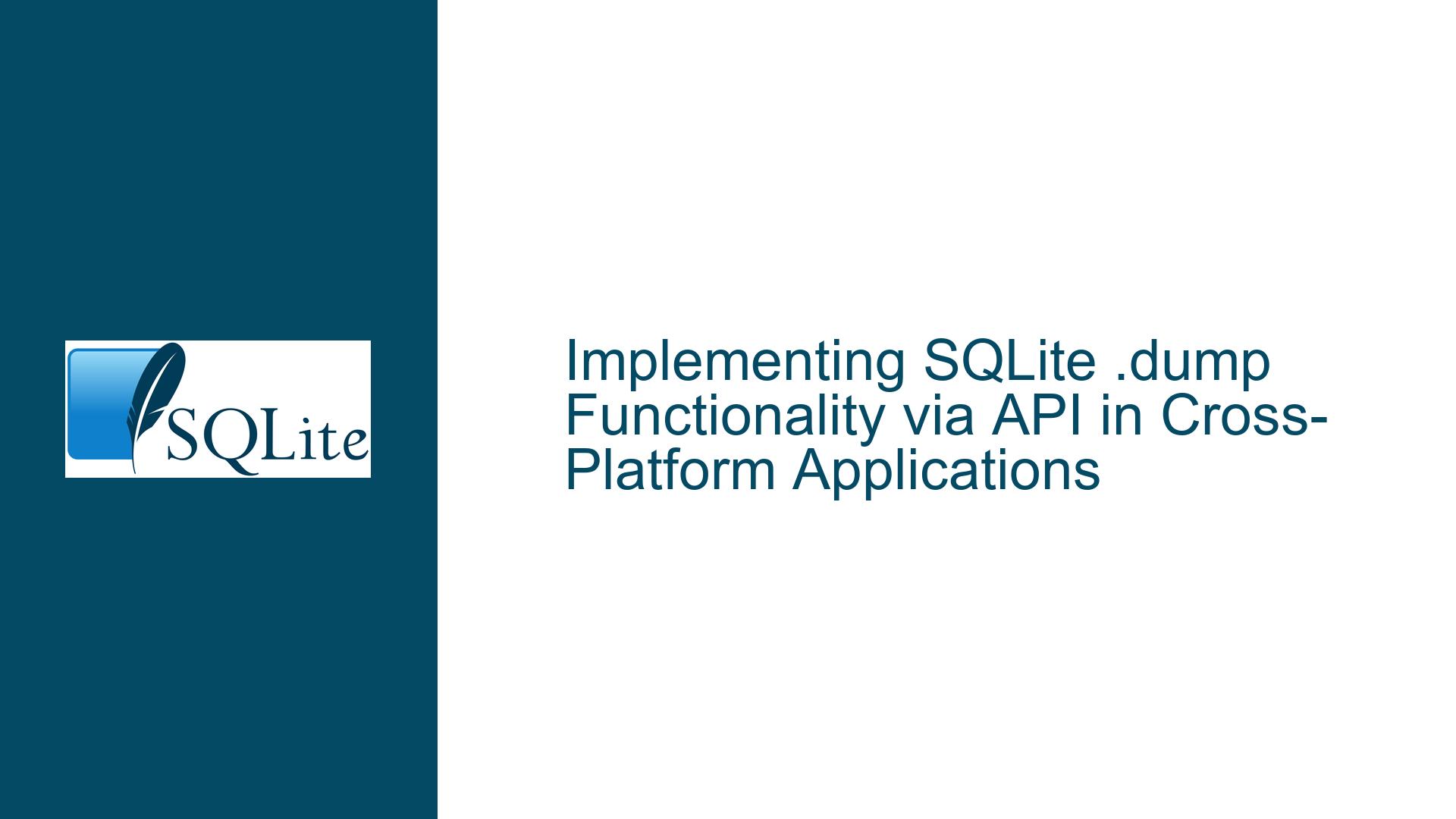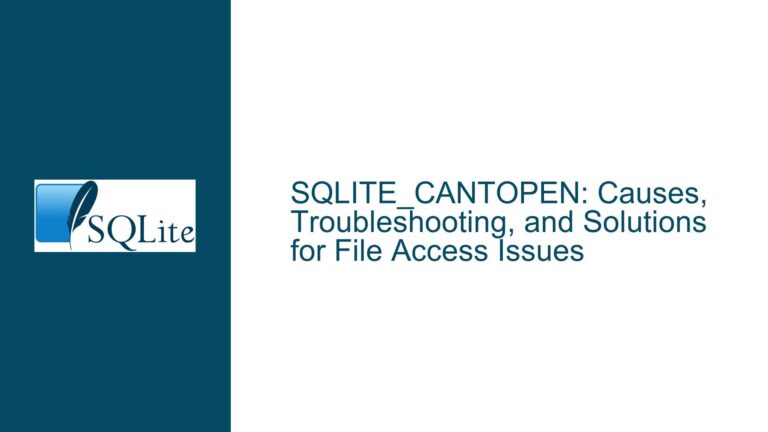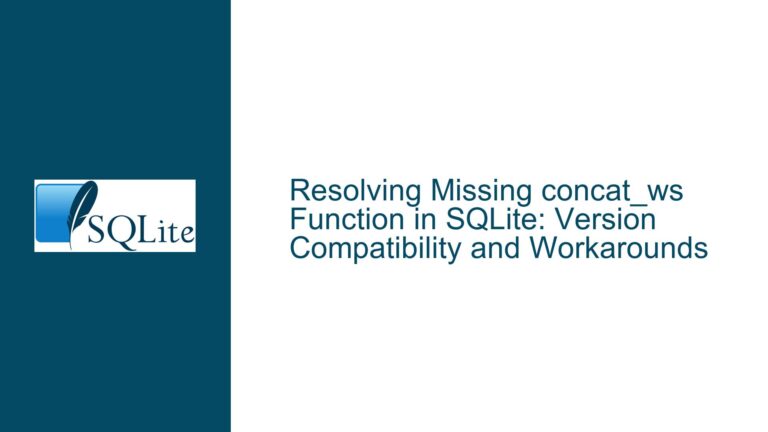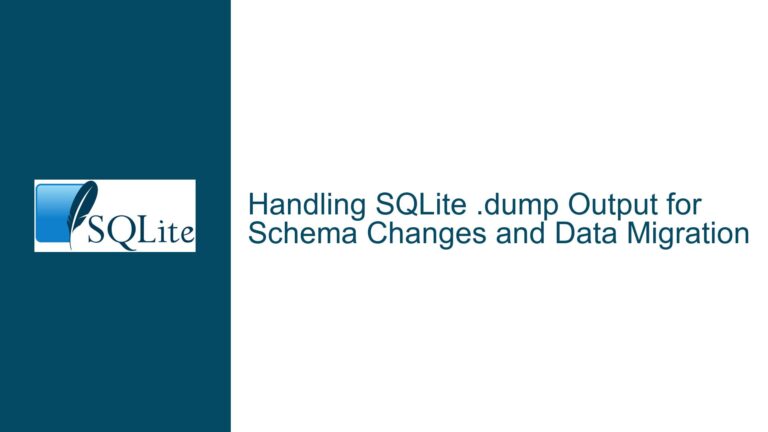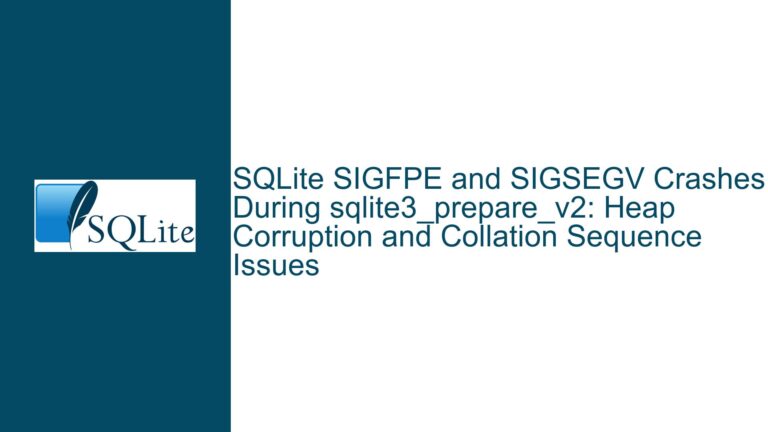Implementing SQLite .dump Functionality via API in Cross-Platform Applications
Understanding the Core Challenge of Programmatic Database Dumping
The SQLite command-line shell’s .dump command is a critical utility for generating a complete SQL script that reconstructs a database’s schema and data. Developers seeking to replicate this functionality programmatically – particularly in cross-platform applications like those built with QT – face a multi-layered challenge. Unlike the convenience of invoking .dump in an interactive shell, there is no single API function in SQLite that directly produces this output. Instead, developers must orchestrate a sequence of API calls to extract schema metadata, table data, and auxiliary objects (such as triggers and indexes) while adhering to transactional integrity and SQL formatting rules. This process requires deep familiarity with SQLite’s internal data structures, the sqlite3_exec() family of functions, and the nuances of SQL script generation.
The absence of a built-in .dump equivalent in the SQLite C API forces developers to reverse-engineer the logic embedded in the shell.c source file. This file contains the implementation of the .dump command, which iterates through system tables like sqlite_schema, constructs CREATE statements, and emits INSERT commands for table rows. Programmatic replication demands careful handling of edge cases, such as BLOB data encoding, foreign key constraints, and temporary tables, which are automatically addressed by the shell but require explicit management when using the API. Cross-platform considerations add further complexity, as applications must ensure compatibility with different filesystems, threading models, and SQLite compilation options.
Key Obstacles to Replicating .dump Behavior via API
1. Lack of Unified API Endpoint for Schema/Data Serialization
SQLite’s API is designed for granular database operations, not bulk script generation. While functions like sqlite3_exec() allow execution of arbitrary SQL, they do not natively support the aggregation of schema definitions and row data into a coherent script. The .dump command in the shell is a higher-order abstraction that combines multiple low-level operations: querying system catalogs, formatting SQL statements, and managing transaction boundaries. Developers must reimplement this orchestration layer, which involves parsing the sqlite_schema table, iterating through user-defined tables, and dynamically generating INSERT statements with properly escaped values.
2. Disconnect Between Shell Environment and Application Context
The SQLite shell operates in an environment where stdout is directly accessible, and commands like .dump can stream results to a file or console. In contrast, QT applications and other GUI frameworks typically require output to be captured in memory buffers or written to application-managed file handles. This necessitates redesigning the output mechanism to integrate with QT’s I/O subsystems, such as QFile or QTextStream, while preserving the streaming behavior of the original .dump implementation to avoid excessive memory consumption during large database exports.
3. Transaction and Dependency Management
A faithful .dump replica must emit SQL commands in an order that respects object dependencies. For example, tables referenced by foreign keys must be created before their dependents, and views must follow the tables they query. The shell achieves this through a specific traversal order of the sqlite_schema table, but replicating this requires understanding SQLite’s schema storage format. Additionally, the shell wraps the entire dump in a transaction to ensure atomicity, which developers must manually enforce using BEGIN and COMMIT statements when using the API.
Comprehensive Strategy for API-Driven Database Dumping
Phase 1: Schema Extraction and Formatting
Begin by querying the sqlite_schema (formerly sqlite_master) table to retrieve all user-defined objects. Use a SQL query such as:
SELECT type, name, sql FROM sqlite_schema
WHERE sql NOT NULL AND name NOT LIKE 'sqlite_%'
ORDER BY type DESC, name ASC;
This fetches tables, indexes, triggers, and views, ordered to ensure tables are created before dependent objects. Process each row:
- For
tabletypes, emit theCREATE TABLEstatement verbatim unless the table is a virtual table (identified bysqlcontainingUSING). - For
indexandtriggertypes, append their SQL definitions after table creation. - For
viewtypes, defer emission until after all tables are created to satisfy dependencies.
Use sqlite3_exec() with a callback function to capture the schema SQL. Note that the sql column in sqlite_schema stores the original DDL, including comments and formatting, which should be preserved for accuracy.
Phase 2: Data Export via Row Iteration
For each user table, generate INSERT statements containing all rows. This requires:
- Dynamic SQL Construction: Build a
SELECT * FROM "table_name";query, usingsqlite3_mprintf()to safely quote identifiers. - Prepared Statement Execution: Use
sqlite3_prepare_v2()andsqlite3_step()to iterate through rows. - Value Escaping and Formatting: For each row, extract column values using
sqlite3_column_*()functions and apply proper SQL escaping. Binary BLOBs must be converted to hexadecimal literals (e.g.,X'0123ABCD'). - Batch Insert Optimization: To improve performance for large tables, consider batching multiple rows into a single
INSERTstatement, respecting SQLite’s maximum SQL statement length (default 1,000,000 bytes).
Example code snippet for row processing:
sqlite3_stmt *stmt;
const char *selectFmt = "SELECT * FROM \"%w\";";
char *selectSql = sqlite3_mprintf(selectFmt, tableName);
if (sqlite3_prepare_v2(db, selectSql, -1, &stmt, NULL) == SQLITE_OK) {
while (sqlite3_step(stmt) == SQLITE_ROW) {
// Build INSERT statement using sqlite3_column_*()
}
}
sqlite3_finalize(stmt);
sqlite3_free(selectSql);
Phase 3: Transaction and Concurrency Management
Wrap the entire dump in a transaction to ensure consistency:
BEGIN IMMEDIATE;
PRAGMA foreign_keys=OFF;
PRAGMA writable_schema=ON; -- Only if schema modifications are needed
... (schema and data)
PRAGMA foreign_keys=ON;
COMMIT;
Use sqlite3_exec(db, "BEGIN IMMEDIATE;", NULL, NULL, NULL); to start the transaction. Disable foreign keys during import to prevent constraint violations when inserting data out of dependency order. Re-enable them after COMMIT.
Phase 4: Integration with QT Framework
In QT applications, direct file writes should be replaced with QFile operations. For example:
QFile dumpFile("output.sql");
if (dumpFile.open(QIODevice::WriteOnly)) {
QTextStream stream(&dumpFile);
// Emit schema to stream
// Emit data to stream
}
Ensure thread safety by confining SQLite API calls to a single thread or using mutexes if accessing the database connection across multiple threads. For asynchronous dumping, consider using QT’s signals and slots to report progress or completion.
Phase 5: Handling Edge Cases and Validation
- Virtual Tables: Skip tables where
sqlcontainsUSING, as they cannot be recreated via standard DDL. - ROWID Tables: Explicitly include the
ROWIDif the table usesWITHOUT ROWID. - Collation Sequences: Custom collations defined via
sqlite3_create_collation()must be recreated in the target environment. - Attached Databases: If using
ATTACH DATABASE, extend the logic to iterate through all attached schemas.
Validate the generated script by creating a new database and running the dumped SQL against it. Use the sha3sum SQLite extension to compare the original and restored database hashes for verification.
This guide provides a foundation for implementing .dump-equivalent functionality via SQLite’s API, emphasizing the intricate interplay between schema introspection, data serialization, and platform integration. Developers must adapt these techniques to their specific use case, rigorously testing for data fidelity and performance across target platforms.
